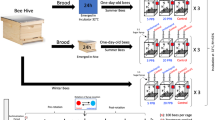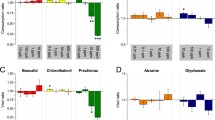Abstract
Recent studies have shown the occurrence of plant derived pyrrolizidine alkaloids (PAs) in retail honeys and pollen loads, but little is known about how these compounds influence the fitness of foraging honey bees. In feeding experiments, we tested a mix of tertiary PAs and the corresponding N-oxides from Senecio vernalis, pure monocrotaline, and 1,2-dihydromonocrotaline in 50% (w/w) sucrose solutions. The bees were analyzed chemically to correlate the observed effects to the ingested amount of PAs. PA-N-oxides were deterrent at concentrations >0.2%. 1,2-Unsaturated tertiary PAs were toxic at high concentrations. The observed PAs mortality could be linked directly to the presence of the 1,2-double bond, a well established essential feature of PA cytotoxicity. In contrast, feeding experiments with 1,2-dihydromonocrotaline revealed no toxic effects. Levels of less than 50 μg 1,2-unsaturated tertiary PAs per individual adult bee were tolerated without negative effects. PA-N-oxides fed to bees were reduced partially to the corresponding tertiary PAs. Unlike some specialized insects, bees are not able to actively detoxify PAs through N-oxidation. To gain insight into how PAs are transmitted among bees, we tested for horizontal PA transfer (trophallaxis). Under laboratory conditions, up to 15% of an ingested PA diet was exchanged from bee to bee, disclosing a possible route for incorporation into the honey comb. In the absence of alternative nectar and pollen sources, PA-containing plants might exhibit a threat to vulnerable bee larvae, and this might affect the overall colony fitness.







Similar content being viewed by others
References
Adler, L. S. 2000. The ecological significance of toxic nectar. Oikos 91:409–420.
Baker, H. G. 1977. Non-sugar chemical constituents of nectar. Apidologie 8:349–356.
Betteridge, K., Cao, Y., and Colegate, S. M. 2005. Improved method for extraction and LC-MS analysis of pyrrolizidine alkaloids and their N-oxides in honey: Application to Echium vulgare honeys. J. Agric. Food Chem. 53:1894–1902.
Boppré, M., Colegate, S. M., and Edgar, J. A. 2005. Pyrrolizidine alkaloids of Echium vulgare honey found in pure pollen. J. Agric. Food Chem. 53:594–600.
Boppré, M., Colegate, S. M., Edgar, J. A., and Fischer, O. W. 2008. Hepatotoxic Pyrrolizidine Alkaloids in Pollen and Drying-Related Implications for Commercial Processing of Bee Pollen. J. Agric. Food Chem. 56:5662–5672.
Culvenor, C. C. J. 1980. Alkaloids and human disease, pp. 124–141, in R. L. Smith and E.A. Bababunmi (eds.). Toxicology in the Tropics. Taylor and Francis, London.
Culvenor, C. C., Edgar, J. A., Jago, M. V., Qutteridge, A., Peterson, J. E., and SMITH, L. W. 1976. Hepato- and pneumotoxicity of pyrrolizidine alkaloids and derivatives in relation to molecular structure. Chemico-biological Interactions 12:299–324.
Cymerman Craig. J., and Purushothaman, K. K. 1970. Improved preparation of tertiary amine N-oxides. J. Org. Chem. 35:1721–1722.
Deinzer, M. L., Thomson, P. A., Burgett, D. M., and Isaacson D. L. 1977. Pyrrolizidine alkaloids: Their occurrence in honey from tansy ragwort (Senecio jacobaea L.). Science 195:497–499.
Detzel, A., and Wink, M. 1993. Attraction, deterrence or intoxication of bees (Apis mellifera) by plant alelochemicals. Chemoecology 4:8–18.
Edgar, J. A., Roeder, E., and Molyneux, R. J. 2002. Honey from plants containing pyrrolizidine alkaloids: a potential threat to health. J. Agric. Food Chem. 50:2719–2730.
Eisner, T., Rossini, C., Gonzalez, A., Ivengar, V. K., Siegler, M. V. S., and Smedley, S. R. 2002. Paternal investment in egg defence, pp. 91–116, in M. Hilker, and T. Meiners (eds.). Chemoecology of Insect Eggs and Egg Deposition vol. Blackwell, Oxford.
Frei, H., Luthy, J., Brauchli, J., Zweifel, U., Wurgler, F. E., and Schlatter, C. 1992. Structure/activity relationships of the genotoxic potencies of sixteen pyrrolizidine alkaloids assayed for the induction of somatic mutation and recombination in wing cells of Drosophila melanogaster. Chem. Biol. Interact 83:1-22.
Fu P. P., Xia Q., Lin G., and Chou M. W. 2004. Pyrrolizidine alkaloids—genotoxicity, metabolism enzymes, metabolic activation, and mechanisms. Drug Metab. Rev. 36:1–55.
Gaffal, P. K., and Gammal, E. 2003. Nektar und Honiganalyse als Prognose für den Phloemtransport von natürlichen Pflanzengiften? Drogenreport 16:9–17.
Gegear, R. J., Manson, J. S., and Thomson, J. D. 2007. Ecological context influences pollinator deterrence by alkaloids in floral nectar. Ecology Letters 10:375–382.
Gould, J. L., and Gould, C. G. 1995. The Honey Bee. Scientific American Library, New York.
Hartmann, T., and Ober, D. 2008. Defense by pyrrolizidine alkaloids: developed by plants and recruited by insects, pp. 213–231, in A. Schaller (ed.). Induced Plant Resistance to Herbivory. Springer.
Hartmann, T., and Toppel, G. 1987. Senecionine N-oxide, the primary product of pyrrolizidine alkaloid biosynthesis in root cultures of Senecio vulgaris. Phytochemistry 26:1639–1643.
Hartmann, T., and Witte, L. 1995. Chemistry, biology and chemoecology of the pyrrolizidine alkaloids, pp. 155–233, in S. W. Pelletier (ed.). Alkaloids: Chemical and Biological Perspectives, vol. 9. Pergamon, Oxford.
Kempf, M., Beuerle, T., Bühringer, M., Denner, M., Trost, D., von der Ohe, K., Bhavanam, V. B., and Schreier, P. 2008. Pyrrolizidine alkaloids in honey: risk analysis by gas chromatography-mass spectrometry. Mol. Nutr. Food Res. 52:1193–1200.
Landolt, P. J., and Lenczewski, B. 1993. Lack of evidence for the toxic nectar hypothesis: a plant alkaloid did not deter nectar feeding by Lepidoptera. Fla. Entomol. 76:556–566.
Lindigkeit, R., Biller, A., Buch, M., Schiebel, H. M., Boppré, M., and Hartmann, T. 1997. The two faces of pyrrolizidine alkaloids: The role of the tertiary amine and its N-oxide in chemical defense of insects with acquired plant alkaloids. Eur. J. Biochem. 245:626–636.
Macel, M., Bruinsma, M., Dijsktra, S. M., Ooijendijk, T., Niemeyer, H. M., and Klinkhamer, P. G. L. 2005. Differences in effects of pyrrolizidine alkaloids on five generalist insect herbivore species. J. Chem. Ecol. 31:1493–1508.
Marín-Loaiza, J. C., Ernst, L., Beuerle, T., Theuring, C., Céspedes, C. L., and Hartmann, T. 2008. Pyrrolizidine alkaloids of the endemic Mexican genus Pittocaulon and assignment of stereoisomeric 1,2-saturated necine bases. Phytochemistry 69:154–167.
Masters, A. R. 1991. Dual role of pyrrolizidine alkaloids in nectar. J. Chem. Ecol. 17:195–205.
Mattocks, A. R. (ed) 1986. Chemistry and Toxicology of Pyrrolizidine Alkaloids. Academic, London.
Narberhaus, I., Zintgraf, V., and Dobler, S. 2005. Pyrrolizidine alkaloids on three trophic levels—evidence for toxic and deterrent effects on phytophages and predators. Chemoecology 15:121–125.
Nicolson, S. W., and Thornburg, R. W. 2007. Nectar chemistry, pp. 215–264, in S. W. Nicolson, M. Nepi, and E. Pacini (eds.). Nectaries and Nectar. Springer, Dordrecht.
OECD/OCDE 1998. OECD guidelines for the testing of chemicals, Honeybees, Acute Toxicity Test.
Raguso, R. A. 2008. Start making scents: the challenge of integrating chemistry into pollination ecology. Ent. Exper. Appl. 128:196–207.
RIVM Rijksinstituut voor Volksgezondheid en Milieu. 2007. RIKILT Institute of Food Safety, Risicobeoordeling inzake de Aanwezigheid van Pyrrolzidine Alkaloiden in Honing, http://www.vwa.nl/cdlpub/servlet/CDLServlet?p_file_id=22703 (accessed on May 20th, 2009). Wageningen, Netherlands.
Sadasivam, S., and Thayumanavan, B. 2003. Molecular Host Plant Resistance to Pests. CRC, New York, pp 207–209.
Seeley, T. D. 1995. The Wisdom of the Hive: The Social Physiology of Honey Bee Colonies. Harvard University Press, Cambridge.
Singaravelan, N., Nee’man, G., Inbar, M., and Izhaki, I. 2005. Feeding responses of free-flying honeybees to secondary compounds mimicking floral nectars. J. Chem. Ecol. 31:2791–2804.
Stegelmeier, B. L., Edgar, J. A., Colegate, S. M., Gardner, D. R., Schoch, T. K., Coulombe, R. A., and Molyneux, R. J. 1999. Pyrrolizidine alkaloid plants, metabolism and toxicity. J. Nat. Tox. 8:95-116.
Tan, K., Guo, Y. H., Nicolson, S. W., Radloff, S. E., Song, Q. S., and Hepburn, H. R. 2007. Honeybee (Apis cerana) Foraging Responses to the Toxic Honey of Tripterygium hypoglaucum (Celastraceae): Changing Threshold of Nectar Acceptability. J. Chem. Ecol. 33:2209–2217.
Van Dam, N. M., Vuister, L. W. M., Bergshoeff, C., de Vos, H., and van der Meijden, E. 1995. The ‘raison d’etre of pyrrolizidine alkaloids in Cynoglossum officinale: deterrent effects against generalist herbivores. J. Chem. Ecol. 21:507-523.
Witte, L., Rubiolo, P., Bicchi, C., and Hartmann, T. 1993. Comparative analysis of pyrrolizidine alkaloids from natural sources by gas chromatography- mass spectrometry. Phytochemistry 32:187–196.
Acknowledgements
Ms von der Ohe, Ms Schönberger, and Ms Warner are thanked for technical assistance with the handling of bees. This work was supported by the Deutsche Forschungsgemeinschaft (DFG), Bonn, to P. S. project no. SCHR 211/22-1 and SCHR 211/23-1 and to T. B. project no. BE 3200/1-1 and BE 3200/3-1.
Author information
Authors and Affiliations
Corresponding author
Rights and permissions
About this article
Cite this article
Reinhard, A., Janke, M., von der Ohe, W. et al. Feeding Deterrence and Detrimental Effects of Pyrrolizidine Alkaloids Fed to Honey Bees (Apis mellifera). J Chem Ecol 35, 1086–1095 (2009). https://doi.org/10.1007/s10886-009-9690-9
Received:
Revised:
Accepted:
Published:
Issue Date:
DOI: https://doi.org/10.1007/s10886-009-9690-9




